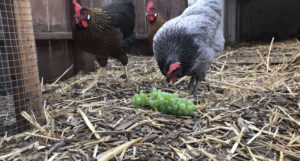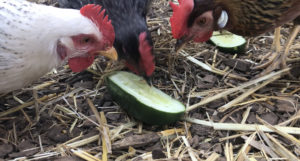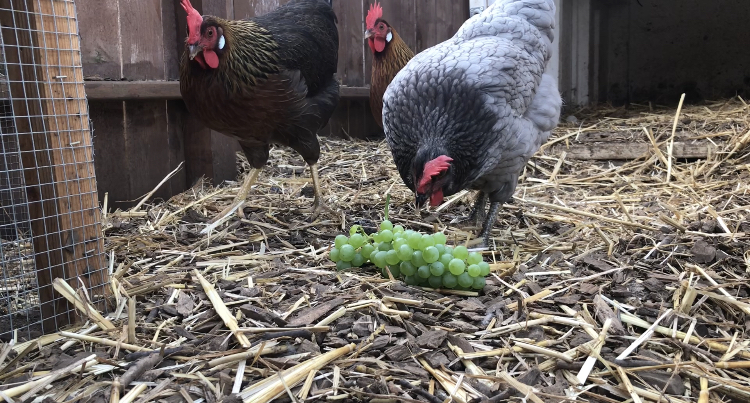Is it a good idea or a bad idea to use wood chips for chicken run ground cover when raising backyard chickens? Overall, wood chips can be a good material to use for an outdoor chicken run, but there are some caveats.
We will break down our approach to using woodchips for our backyard chicken run. From deciding if wood chips make sense for your urban homestead to finding a load of chips to cycling them through the chicken run.

Benefits of Wood Chips for Chicken Run Ground Cover
Woodchips are an excellent ground cover for any backyard poultry run and coop. Both chickens and ducks can be raised on woodchips. If you have to pay for wood chips then avoid using them for a poultry run. However, if you have access to quality chips for free they are excellent for absorbing high amounts of nitrogen in chicken poop.
Free Material
Wood chips are a waste product for most arborists. If you live in an urban area with lots of trees it is very likely you can receive a load for free or almost nothing. Using straw bales is a common ground cover for chicken coops and runs. While a great choice, depending on the size of the area you need to cover the cost of straw bales can get expensive.
Carbon Heavy
Wood chips are very heavy carbon sinks that can absorb large amounts of nitrogen from chicken poop. One of the benefits of having chickens is the free chicken manure for your gardens. After the wood chips have spent several months inside of the chicken run they are ready to be set aside in your compost pile. The final result of this compost is a very rich material that is excellent for applying to backyard orchards or used as mulch around the gardens.
Breaks Down Slowly
Wood chippers create different size chips, big chunky chips will break down very slowly while small quarter-inch chips will break down fast. Arborist chips tend to be chunkier than your typical bag mulch available in box stores. During wet weather, woodchips tend to hold up better compared to straw which can compact and get slippery and nasty.
Chickens Scratch for Bugs in Wood Chips
A chip drop will also include leafy material, sticks, branches, and other material that creates a natural place for your chickens to scratch and peck for tasty snacks. The wood chip ground cover creates an interesting ecosystem of bugs, grubs, and worms over time that can be manually turned by either yourself or the chickens.
Finding a Load of Wood Chips for a Chicken Run
Using chip drop if available in your local area is the best option otherwise consider contacting an arborist or make your own. Ultimately, if you can’t get in touch with an arborist through Chip Drop, calling local tree trimming companies, you can always try flagging down a municipal crew trimming trees along the highway to ask for the chips. How to find woodchips?
- Use Chip Drop if it’s active in your area.
- Contact local arborists
- Rent / Borrow / Buy Wood Chipper
The biggest downside to using tree trimming material is when you get a load there is a lot of it and it needs to sit somewhere. If you have a 8-foot by 6-foot spot you can hold a lot of chips, but be prepared for an arborist to drop off more than twice this amount in a load.
Types of Wood for Chicken Run Ground Cover
Almost all types of wood are acceptable for use in a chicken run as ground cover. However, it is recommended to avoid building your chicken coop out of cedar and so I would avoid using cedar wood chips in the chicken run.
Best Wood Chips for Chicken Runs
- Douglas Fir
- Oak
- Maple
- Alder
- Pine
- Fruit Trees
I prefer a chip load from the late fall, especially if you have a lot of deciduous trees in your area. An arborist load during the middle of the summer will be full of leafy debris which can be ok and work, but I prefer clean chips. Lastly, it is out of your control, but if the chipper is sharp then it will produce a much more uniform chip that will also look good. Dull wood chippers result in lots of long chunks that are not fully cut.
Woodchips to Avoid for Chicken Runs
- Cedar
- Juniper
- Laurels
- Aromatic Evergreens
- Hedges like Arbor Vitae
Try and avoid aromatic wood types. There are compounds in these types of trees and vegetation that can harm backyard chickens and ducks. When an arborist brings a load of woodchips from a hedge job, it will be tons of leafy debris from arborvitae or laurels and I have found this does not make good material for the ground cover in the poultry run.
How to Manage Composting Woodchips in a Chicken Run
We follow a very simple system for managing the composting wood chips in the chicken run using a few hand tools.
Tools Needed
- Wheelbarrow
- Pitchfork
- Rake
That’s it. A quality pitchfork is the best tool for scooping wood chips. Avoid using a shovel when working with woodchips on the homestead. You can easily spread the piles out with the fork, but a rake can make it look perfect.
If you are still at the stage of needing to build a chicken run there are countless options out there. Here is a DIY design that will get you a run for a few birds.
Cycle Wood Chips from Chicken Run to Compost
Plan ahead for a good location to place the pile of wood chips when it is delivered. When bringing in chips for the first time clean the ground in the run. Then bring a few wheelbarrows into the chicken run and smooth it out with a rake. Aim for a depth of 4-6 inches to start. Depending on the design of your run, weather, and poultry flock you may need to go deeper or use even less.
Add fresh wood chips each week or every other week depending on the space in the chicken run. A fresh inch or so of chips each week or two works well.
Every other month or so we scoop out the wood chips from the chicken run and make a compost pile. These chips are allowed to just sit and mature for a period of time and result in a compost garden amendment to enrich the soil with lots of microbiology and nutrients.
A large drop from chip drop is enough wood chips for us to use on our urban homestead for the duration of a year. The first year we established our backyard orchard and poultry we received 5 arborist loads. Now one per year is all we need and we have a spot near the chicken and duck run for stashing chips until they are needed.

Chicken Run with Wood Chips & Straw Makes Wonderful Compost
Can You Use Woodchips in a Chicken Coop?
Of course, however, it might not be the best option for a coop. Most chicken coops are small and have tight spaces. It is important to keep the chicken coop clean and it may be difficult to scoop out the chips versus other bedding materials like straw. Coop designs that have mesh flooring can be difficult to remove wood chips as a pitchfork or shovel will be needed to efficiently scoop them up.
I have used wood chips in the duck coop as duck poop is very watery at times and the heavy carbon chips help absorb this moisture. Our duck coop is also designed to be easily swept out with a push broom and then hosed down making cleaning out chips straightforward.
Keeping a Chicken Run Clean
Heavy carbon materials help keep chicken and duck runs clean by absorbing moisture. Of course, it needs to be sad no one type of chicken run ground cover is going to work maintenance-free. Poultry poop needs to be managed and wood chips are an effective method for managing the poop and subsequently associated smells.
The biggest upside to using chips is the cost, if it is readily available in your region, they will be free.
The biggest downside to using tree trimming material is when you get a load there is a lot of it and it needs to sit somewhere.
Chickens love a clean run with woodchipped ground cover.




Recent Comments